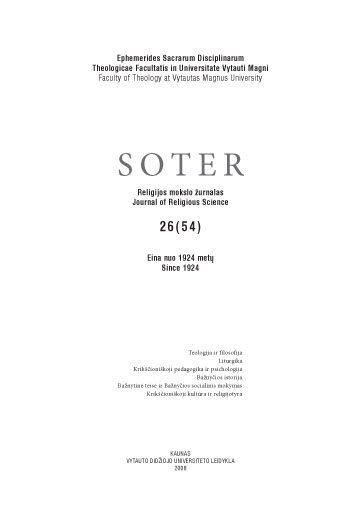Gyvybės kultūra: antropologiniai aspektai
THE CULTURE OF LIFE: ANTHROPOLOGICAL ASPECTS
Author(s): Elena BūgaitėSubject(s): Christian Theology and Religion
Published by: Vytauto Didžiojo Universitetas
Keywords: asmuo; Įsikūnijimas; kūnas; lytiškumas; Švč. Trejybė; bendrystė; šeima; person; Incarnation; lived body; sexuality; Holy Trinity; community; family.
Summary/Abstract: The aim of this article is to analyze some texts on the culture of life, especially paying attention to the human being as a dual existence and the aspect of human body, of human sexuality as most worth of respect, because the sphere of personal diversity and communion, through giving oneself for the other. In the atmosphere of today’s culture, marked by aggressive pansexualism, it is important to seek a real and profound answer to the sense of human reality. Ten years ago John Paul’s II Encyclical “Evangelium Vitae” was an invitation to each person to participate in this widely spread issue, as humanity in each of its members and different communities, especially the members of the families. The article invites rather to seek the answers, to reflect on main human questions. First of all, here is presented the importance of accepting the human reality as a temporality, and to reflect on main relation already analyzed by P. Ricoeur between time and capacity to tell a personal story. The aspect of listening and reflecting is also underlined, especially in the context of today’s technological mentality that leaves fewer and fewer possibilities to a human person for main questions of life. Afterwards, the attention is concentrated to one of classical phenomenologically investigated themes – lived body, such themes as perception according to M.Merleau-Ponty, also the aspect of time in the thought of E. Levinas. The article analyses the thoughts of famous author C. M. Martini, who focuses attention on the Christian view, profoundly marked by the positive attitude and respect towards the human body, which is based on Holy Scripture. Tertullian even maintains that body is the axis of salvation (caro salutis cardo). The mystery of Incarnation is surely of first importance in this context, while researching on human dignity, in spite of or even thanks to its weakest aspect or the sphere of fragility. While accepting our mortal body, the Son of God wanted to participate in our weakness, in the weakness that no more grows over the human dignity (also the dignity of human body). One could even tell that thanks to the mystery of Incarnation, that achieves its full sense in the mystery of Resurrection, the Christianity has as its center the theme of body. The aim of this article is also to enquire the interpretation of human sexuality recently explained by Y. Semens, focusing all the attention to the teaching of John Paul II on his Wednesdays Cathechesis, based on the Holy Scripture. According to the book of Genesis, a man and a woman are the image of God, first of all as the persons, called to community. John Paul II notices, that sexuality maybe is one of the most profound theological aspects, while reflecting everything, we could tell about the human being, because it indicates the mystery of the Holy Trinity. Finally, the article concentrates on the diversity of some basic features, characteristic more of the women or of the men, and to the importance
Journal: SOTER: religijos mokslo žurnalas
- Issue Year: 54/2008
- Issue No: 26
- Page Range: 35-46
- Page Count: 12
- Language: Lithuanian

